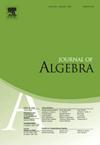边传递三次图:分析,编目和列举
IF 0.8
2区 数学
Q2 MATHEMATICS
引用次数: 0
摘要
研究了自同构群传递作用于图边的有限三次(3正则)图。这类图分为弧传递图和半对称三次图两大类,然后根据某些群银合金分别分为7类(根据djokovovic和Miller(1980)[17])和15类(根据Goldschmidt(1980)[23])。这样的小阶图以前分别被知道到阶为2048和768,我们已经将所有这样的图的两个列表中的每一个扩展到阶为10000。在描述我们如何做到这一点之前,我们对22个汞合金进行了分析,以显示与15个Goldschmidt汞合金相关的有限呈现群中的哪一个可以忠实地嵌入到其他21个中的一个或多个(作为有限指数的子群)中,以补充已经知道的7个Djoković-Miller组相互嵌入的情况。我们也给出了22种类型的图的一个例子,在大多数情况下,描述了最小的这样的图,然后我们使用正则覆盖来证明每种类型有无限多个例子。最后,我们讨论了图阶的渐近枚举,证明了如果fC(n)是C型三次边传递图在最多n个顶点上的个数,那么对于所有n≥0,存在正实常数a、b和正整数n0,使得nalog (n)≤fC(n)≤nblog (n)。本文章由计算机程序翻译,如有差异,请以英文原文为准。
Edge-transitive cubic graphs: analysis, cataloguing and enumeration
This paper deals with finite cubic (3-regular) graphs whose automorphism group acts transitively on the edges of the graph. Such graphs split into two broad classes, namely arc-transitive and semisymmetric cubic graphs, and then these divide respectively into 7 types (according to a classification by Djoković and Miller (1980) [17]) and 15 types (according to a classification by Goldschmidt (1980) [23]), in terms of certain group amalgams. Such graphs of small order were previously known up to orders 2048 and 768, respectively, and we have extended each of the two lists of all such graphs up to order 10000. Before describing how we did that, we carry out an analysis of the 22 amalgams, to show which of the finitely-presented groups associated with the 15 Goldschmidt amalgams can be faithfully embedded in one or more of the other 21 (as subgroups of finite index), complementing what is already known about such embeddings of the 7 Djoković-Miller groups in each other. We also give an example of a graph of each of the 22 types, and in most cases, describe the smallest such graph, and we then use regular coverings to prove that there are infinitely many examples of each type. Finally, we discuss the asymptotic enumeration of the graph orders, proving that if is the number of cubic edge-transitive graphs of type on at most n vertices, then there exist positive real constants a and b and a positive integer such that for all .
求助全文
通过发布文献求助,成功后即可免费获取论文全文。
去求助
来源期刊

Journal of Algebra
数学-数学
CiteScore
1.50
自引率
22.20%
发文量
414
审稿时长
2-4 weeks
期刊介绍:
The Journal of Algebra is a leading international journal and publishes papers that demonstrate high quality research results in algebra and related computational aspects. Only the very best and most interesting papers are to be considered for publication in the journal. With this in mind, it is important that the contribution offer a substantial result that will have a lasting effect upon the field. The journal also seeks work that presents innovative techniques that offer promising results for future research.
 求助内容:
求助内容: 应助结果提醒方式:
应助结果提醒方式:


